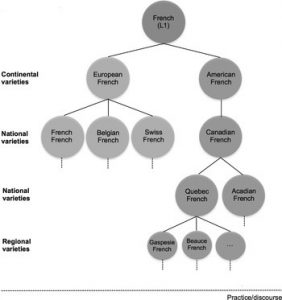Introduction
The aim of the assignment is to familiarize an audience with a complex, technical term through definitions. There will be three types of definitions for the complex, technical term. These definitions are parenthetical definition, sentence definition, and expanded definition. I selected the complex, technical term “pluricentric,” which is often used in sociolinguistic discussions. The audience that I aim to familiarize the complex, technical term is secondary students interested in learning about the relationship between society and linguistics.
Parenthetical Definition
“Pluricentric” describes a language with at least two standard varieties originating from it.
Sentence Definition
“Pluricentric” is used to describe a language that has at least two standard varieties that evolve from it. The standard varieties evolve independently but share certain traits with the language from which they evolved; French is an example.
Expanded Definition
History
German linguist, Heinz Kloss, established the underlying principles of that sociolinguists engage and analyze variants that occur in a language. He coined the term “pluricentric” in the 1970’s. The term describes how one language that is spoken, read, or written can differ between nations. Other linguists in the field, like Rudolf Muhr, have further developed this term to have a set of criteria that languages must adhere to be “pluricentric” in nature.
Example
French is a “pluricentric” language, meaning it has more than one linguistic standard under which it operates. As a result of having more than one linguistic standard, there are differences in pronunciation, vocabulary, and spelling. The “pluricentric” nature of the language is seen in well-established variants such as in France and Canada. While, a language like Japanese has only one standardized version under which it operates, making it a language that is “monocentric.”
Analysis of Parts
A language must satisfy at least two of the following criteria to be called “pluricentric” in nature:
- Occurrence: A language must occur in at least two or more nations that function as an “interacting centre” for the language. The “interacting centre” allows for the language variant to be standardized.
- Official Status: The language has official status in at least two nations either as a state language (German in Austria and Switzerland), a co-state language (German, French, and Italian in Switzerland), or as a regional language (Catalan in France and Spain).
- Linguistic Distance: Standard varieties must have enough distinct linguistic features that differentiate them from other varieties. Thus, giving the ability to serve as a symbol for expressing one’s identity and social uniqueness.
- Acceptance: The language community must accept their language’s status as a pluricentric variant. They must consider it as a component of their social and national identity.
- Relevance to Identity: The variant must be relevant to social identity, be visible in the language community, and lead to some codified norms of its own.
- Codification of Norms: In establishing certainty about common language use, the linguistic norms of the variety must be documented to some extent in reference books to be standardized (such as dictionaries).
Visual

Figure 1: A conceptualization of “pluricentricity” in the French language.
The model in Figure 1 can be understood in relation to the assignment’s previous sub-section (Analysis of Parts). We can ascertain that the language satisfies the following criterion:
- Occurrence: Where the language is spoken in more than two countries (France, Belgium, and Switzerland).
- Official Status: The language serves as a state language (France and Canada), a co-state language (Switzerland and Belgium), and a regional language (Gaspesie and Beauce in Quebec).
- Linguistic Distance: There is enough linguistic distance between the varieties of French (European and American French)
What we can observe from testing the criteria for “pluricentricity” on the model is that the language complies with over two markers. Therefore, we can determine that language is “pluricentric” by sociolinguistics standards.
References in MLA8
Clyne, Michael. “Pluricentric Languages – Introduction.” Pluricentric Languages: Differing Norms in Different Nations. De Gruyter Mouton, Berlin, 1991, pp. 1-10. https://doi.org/10.1515/9783110888140.1.
Muhr, Rudolf . “The State of the Art of Research on Pluricentric Languages: Where We Were and Where We Are Now.” Pluricentric Languages and Non-Dominant Varieties Worldwide. Peter Lang Publishing, Bern, 2016, pp. 9-32. https://doi.org/10.3726/978-3-653-07112-2.
Oakes, Leigh and Yael Peled. “Pluricentric Linguistic Justice in Quebec: Beyond the Monocentric Ideology.” Normative Language Policy: Ethics, Politics, Principles, Cambridge University Press, Cambridge, 2017, pp. 104–134. https://doi.org/10.1017/CBO9781316534267.005.
Leave a Reply